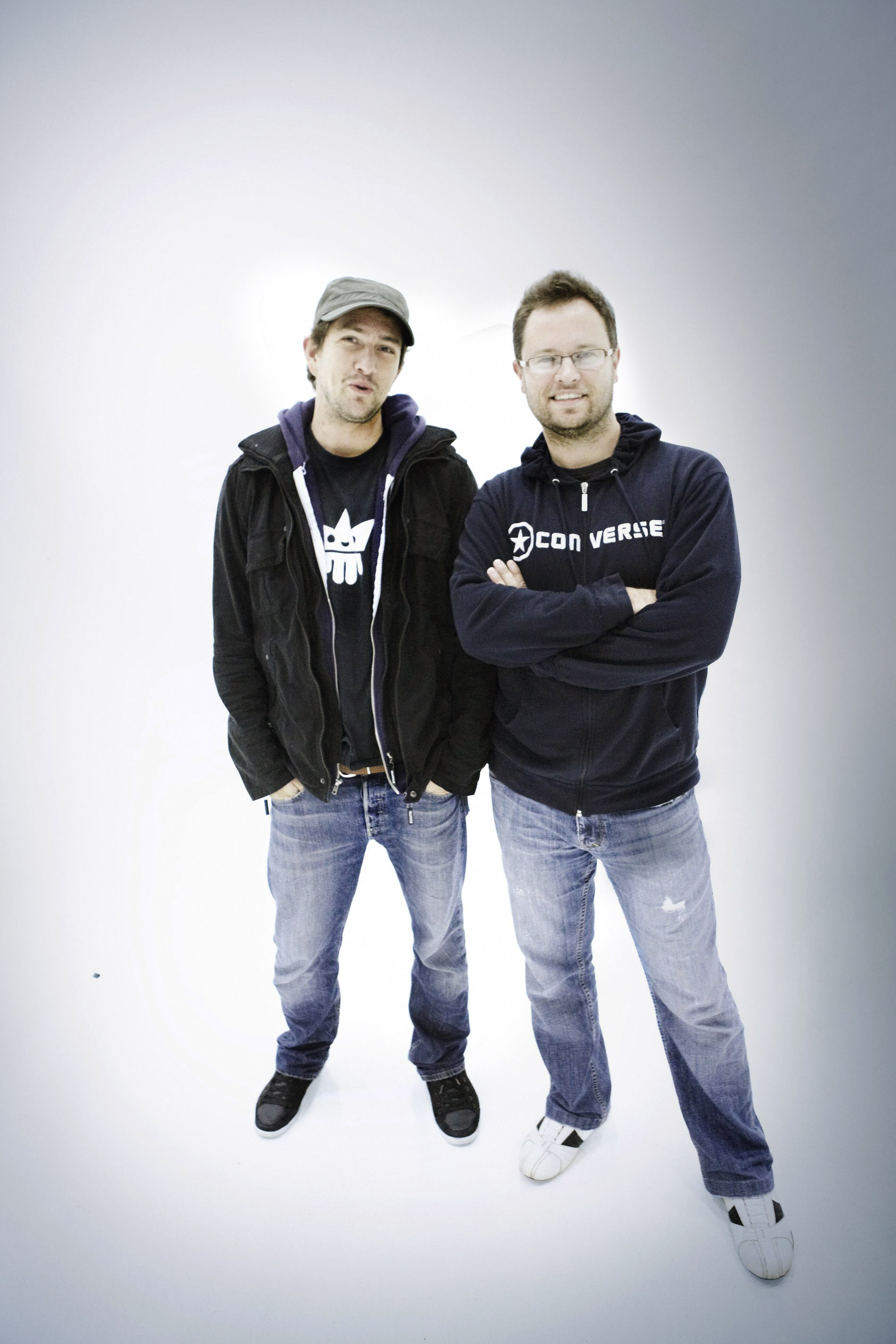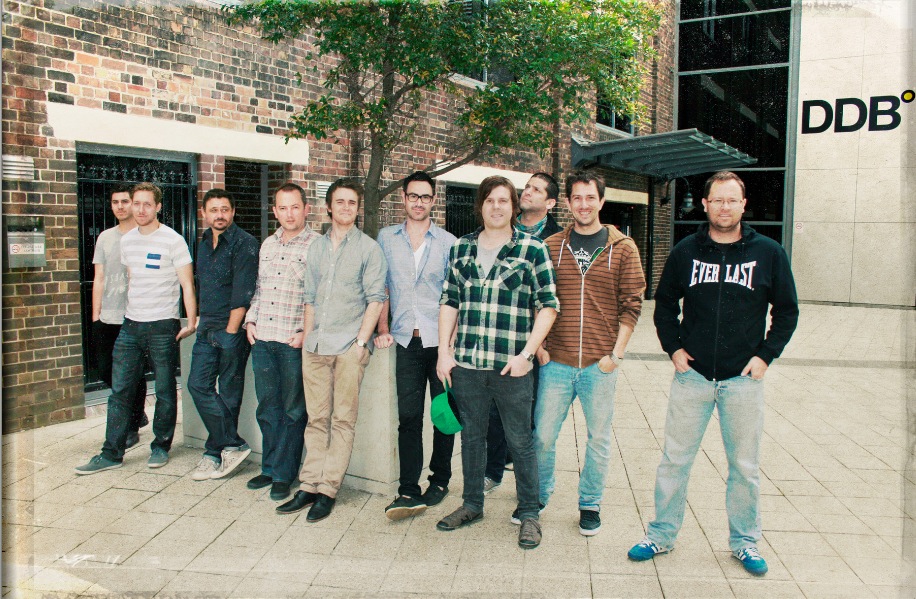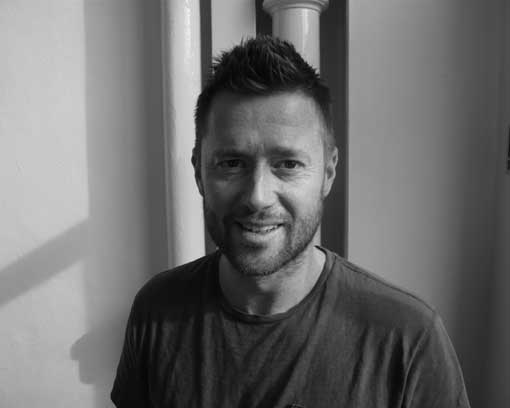DDB Sydney beefs up creative department with eight appointments including May and Eberhardt
 CB Exclusive – DDB Group Sydney continues to strengthen the calibre of the creative department with the addition of a wealth of local talent. New joiners to the DDB Group Sydney creative team include:
CB Exclusive – DDB Group Sydney continues to strengthen the calibre of the creative department with the addition of a wealth of local talent. New joiners to the DDB Group Sydney creative team include:
Steve May and Nils Eberhardt (left) – Group Creative heads.
Working primarily on Wrigley’s and Volkswagen, Steve May and Nils Eberhardt have joined from Saatchi & Saatchi Sydney. Both have picked up gongs in Cannes, The One Show, D&AD book and have worked on brands including Toyota, Toohey’s Extra Dry, Foxtel, Cadbury, Westpac, NRL and David Jones.
Richard Apps and Andrew Allsop – Senior Art Director and Senior Copywriter
Working at agencies including Ogilvy and JWT Australia, Apps has been involved in numerous high profile global campaigns including a commercial voted one of the BBC‚s Top 20 favorite ads of all time, re-launching the Chrysler Jeep Cherokee, the HSBC Waratah rugby team sponsors Jersey23 campaign and award winning ideas for Thrifty Car Rentals, Lipton, HSBC and Siemens Mobile.
Allsop joins as Senior Art Director working across McDonald‚s and the DDB Group client base. He joins the creative team as senior copywriter to work across a mix of the DDB Group client base. Prior to joining DDB Group Sydney, heworked at the likes of Ogilvy, The Furnace, Arnold and Publicis Mojo on brands including Skins, Peugeot, Powerade, Fairfax Digital, HP, Victorian Tourism and KFC. His work has been acknowledged at Cannes, London International, One Show, AWARD, Caxtons as well as a print campaign for Radiator Wetsuits being hung in the Palais Du Louvre, Paris in 2007.
 Simon O’Neil – Senior Interactive Art Director
Simon O’Neil – Senior Interactive Art Director
Having spent five years working in Germany specialising in digital media, O’Neil worked at BBDO Interone Worldwide and Kolle Rebbe as Senior Digital Art Director, working on the likes of BMW, MINI, Nike Football, NIVEA, Lufthansa & Warsteiner. After a brief stint as a freelancer back in Sydney, he joined DDB Group Sydney last month to work on Telstra, Volkswagen, McDonald’s and Gatorade.
Lazrus Simons – Senior Digital Writer
With work shortlisted at the Caxtons, Spikes and a JuiceTV Music Award for co-directing his own music video, Simons has spent the last few years working at Cambodian. Previously he also worked at agency Riverorchid as well as Mojo, JWT and Colenso in New Zealand on clients including Unilever, KFC, Audi and Canon.
Rich Robson and Jon Austin – Art Director and Copywriter
The creative duo join from Saatchi & Saatchi New Zealand. Working on Sealord’s Naked Panda launch, Telecom’s Abstain For The Game and Weetbix’s sponsorship of the All Blacks.
 Says Dylan Harrison (left), DDB Group Sydney’s executive creative director: “New talent and the inspiration and vitality they bring are the lifeblood of a creative department. I‚m delighted off the back of our continued business success to welcome these players in the next chapter of our evolution as an agency
Says Dylan Harrison (left), DDB Group Sydney’s executive creative director: “New talent and the inspiration and vitality they bring are the lifeblood of a creative department. I‚m delighted off the back of our continued business success to welcome these players in the next chapter of our evolution as an agency
“It’s a simple equation. We have a wealth of creative opportunities across the breadth of diverse clients within our group. To convert these into great work, we need to continue to grow and attract the best creative talent. The diversity of our creative environment at DDB Sydney reflects our ambition to do the most innovative and exciting work in the country. Already these guys, from a mixture of backgrounds, are demonstrating their unique talents.”

19 Comments
Wow, someone actually admits to involvement in that Telecom Abstain fiasco?
Good on you Stevie May, as Connery would say, “That’s Fantashtic!
Looking slim and sexy Stevie May!
Beef up is right. No chickens?
DDBOOOOOOOM!
May = champ.
PWINEAPPLEEE JUICE!!
Look, all you guys are obviously mates of these clowns. Stop commenting unless you have something to say.
Blokes.
AWEsomeness!
The push to allow women to work in a creative department must be the strangest of all aberrations indulged in by the women’s liberation or feminist movement. The very idea of women presenting creative in a meeting is so unnatural that it almost sounds like a death wish for our species.
Has our nation sunk so low that we are willing to send our daughters and young mothers into pitches? Is chivalry completely dead? Breathes there a man with soul so dead that he will not rise up and defend his wife, his sweetheart, his mother and his daughter, against those who want to wound or capture their ideas, whoever they may be?
Most Australians were shocked to learn that at least one Australian woman is an executive creative director overseas (and a couple of other women are CDs), but the feminists see this as proof that women are advancing toward equality with men on the creative front. In point of fact, women in business are not equal, whether they are Australian women or hairy armpitted Frenchies.
Shauna Johnson, age 30, of Bondi Junction, the single mother of a two-year-old daughter, was part of a Grey Sydney creative team ambushed and captured after the pair won a bronze lion. She had signed up to be a suit and never dreamed she would be sent into a situation where she could come up with ideas and have them made.
This is not only a tragedy for Shauna, it’s a humiliation for advertising and a step backward for civilization. No crisis or threat requires our board members to send mothers of two-year-old babies across the harbour to fight the most brutal CEOs and CMOs in the country.
The feminists, however, view Shauna as a pioneer for women’s rights. An AdNews editorial brags that Shauna’s recruitment shows how the ad industry has “evolved” and “the case for equal footing is gaining ground.” But, the writer bemoans, the industry is “a laggard on the topic of women in creative” and still retains “glass ceilings” that bar women from direct ideation. That is the kind of equality the feminist movement has always sought.
My agency’s regulations have always exempted women from directly presenting, but the Gillard feminists opened up more “career opportunities” for women by getting the parliament to eliminate the then-existing “Risk Rule,” a regulation that had exempted women in non-creative positions from assignment where they faced the “inherent risk of crying.”
There is no evidence in all history for the proposition that the assignment of women to creative jobs is the way to advance women’s rights, promote consumer products, improve agency life, or win pitches. Indeed, the entire experience of recorded history teaches us that pitches are not won by coed creative teams. Of the thousands of books written about DDB, no one ever wrote that Bernbach or the clients should have solved their manpower shortage problem by using women in creative.
Every agency that has experimented with women in creative has abandoned the idea. The notion that W+K uses women in creative is a feminist myth. Women are treated very differently from men in the Wiedens ranks. They serve only about half as long; they are housed in separate offices; they have an automatic dismissal if they marry or have a baby. Commenting on the sex-integration practices of the UK ad industry, one W+K creative director said, “We do not do what you do in the United Kingdom because, unfortunately, we have to take advertising seriously.”
Women, on the average, have only 60 percent of the creative ability of men. This truism, so self-evident to those with eyes to see, has been confirmed by many studies, but under pressure from militant feminists, the brave men with award trophies decorating their offices are defensive about the obvious. Omniocom’s Worldwide CEO reported, “If as the BBDO creative board has concluded, females are only 60 percent as creative as males, it seems there are some jobs that males, on the average, can do better than females.”
When David Ogilvy delivered his great “Sell, Sell, Sell” speech at Madison Avenue on May 12, 1962, he gave it to them straight. “Your mission remains fixed, determined, inviolable. It is to sell products.” Ogilvy explained that building brands requires real men who, whether they are “slogging ankle deep through mire of research reports, . . . blue-lipped, covered with sludge and mud, chilled by the wind and rain on a shoot,” or in “the filth of dirty edit suites, the isolation of ghostly sound booths, the bad coffee of postproduction houses,” in “the loneliness and utter desolation of having no idea the day before,” can be relied on to muster the innovation and creativity to crack the brief.
Tools have changed, but the mission of the ad industry is the same. It is a mission for tough, tenacious and courageous men who can endure the most primitive and uncivilized clients’ minds and pain in order to survive in business against account service people who are just as tough, tenacious and courageous, and often vicious and sadistic, too. The writers and art directors of every agency are exclusively male and no women diminish their creative powers.
Another reason for the unanimous verdict of history that the industry demand different roles for men and women is that women get pregnant. When young men and women in the age group of 18 to 25 are required to work in close proximity, often doing unpleasant tasks and suffering from loneliness at 3am the night before a presentation, the inevitable happens. The pregnancy rate is at least 10 percent among advertising women. Another five percent have had their babies and brought them back to work. Why is anyone surprised?
How did we get into our present situation, in which our creative directors are approving maternity leave, opening nurseries in agencies, and pretending that women can do anything that men can do? For the answer to that, we must look at two feminist fantasies.
The first is that there really is no difference between the sexes (except those obvious ones we need not discuss) and that all those other differences you think you see are not inherent, but are due merely to cultural stereotyping which can and must be erased by sex-neutral education, laws, and changed attitudes.
The feminists’ chief legal authority prior to Ruth Bader Ginsburg was Yale Law School Professor Thomas I. Emerson. He explained the feminist view in a 100-page, widely quoted article about the Equal Rights Amendment in the Yale Law Journal (April 1971). “As between brutalizing our young men and brutalizing our young women,” he wrote, “there is little to choose. . . Women will serve in all kinds of departments, and they will be eligible for creative duty.”
The second false dogma of the women’s liberation movement is that we must be neutral as between morality and immorality, and as between the institution of the family and alternate lifestyles. As the national conference on International Women’s Year at Houston in 1977 proved, the feminists demand that government policy accord the same dignity to lesbians and prostitutes as to wives, to illegitimate births as to legitimate, to abortions as to live births, and that we support immoral and anti-family practices with public funds.
The great and powerful Communications Council has been pretending there is no difference between men and women, even if they are mothers, and that giving birth to a baby is only a temporary disability like breaking a leg. To carry on this pretense, official AFA policy has been ignoring common sense, family integrity, and the Aussie culture. The deception appeared to some to be satisfactory in the time between pitches when women were pursuing their career opportunities for upward social mobility, as the feminists like to say. Then came a real presentation.
The politicians have brought this embarrassment on our industry because they allowed themselves to be henpecked by the militant feminists. The whole idea of men sending women, including mothers, out to create advertising is uncivilized, degrading, barbaric, and embarrassing. It’s contrary to our culture, to our respect for men and women, and to our belief in the importance of the family and motherhood. No one respects a man who would let a woman do his thinking for him.
We hear the constant refrain that “times have changed,” but there is no change whatsoever in obvious facts of human nature such as that men and women differ in so many important ways, that healthy young women are apt to get pregnant, and that there is a profound difference between male-to-male bonding and male-to-female bonding — a factor that can make the difference between laughter and tears in the creative department. No matter what social changes are alleged to have taken place, the policies of our agencies should respect the dignity and value of marriage and motherhood.
Women serve our industry admirably, both on the catering front and in many positions in production and account service. But they should not be assigned to creative or to creative areas where they have the “inherent risk of crying.”
Dear Self Comment,
Do you come from the school of Unless You Have An Anonymous, Snide Remark To Make, Don’t Say Anything At All? What’s wrong with congratulating these guys, friends or otherwise?
Good on you Stevie and the rest.
T.
Time for May to start a look-a-like wall over there
Darling, time for your milk.
Oh shit. Woman or man, it does not matter, there are only two types of people in the creative department these days. Wankers and fuckwits. Unfortunately, you fall into the later category.
I won’t go into the first woman employed by DDB by Bernbach. Please google it, but listen closely, you’re a useless lesson in insanity.
THE REASON YOU DO NOT HAVE A JOB IS NOT BECAUSE YOU’RE BLACK, WHITE, ASIAN OR GYPSY, IT IS BECAUSE YOU ARE A COCK. FEMALE/MALE OR OTHERWISE, YOU SIMPLY DON’T HAVE WHAT IT TAKES.
I want my high-horse back thank you very much.
Sweety, please do the right thing by other successful female creatives and humbly FUCK. OFF.
Great job Nils! Lucky to have you.
wow. just wow.
TL/DR
Creatives are hired for their brains, not for their dicks.